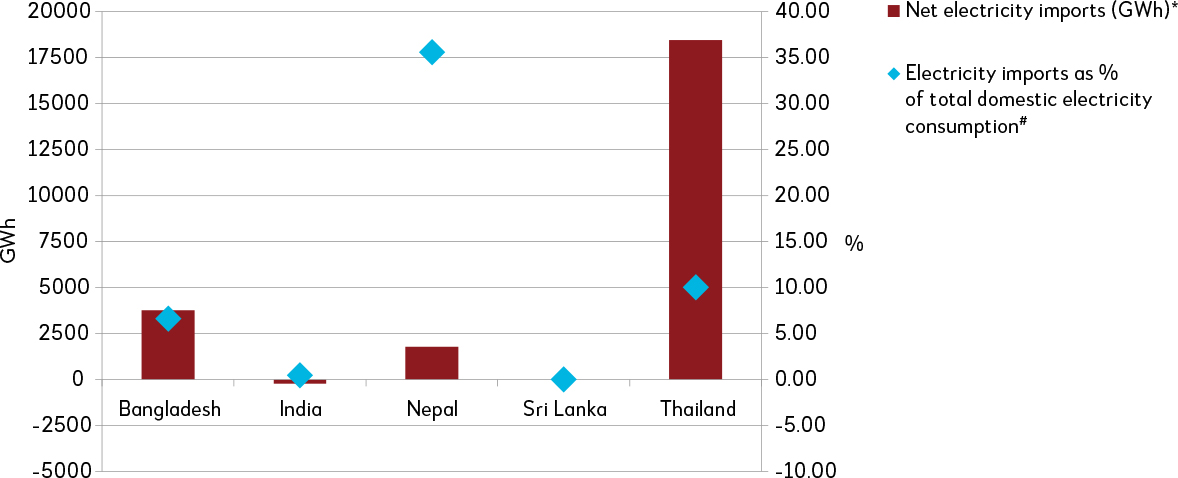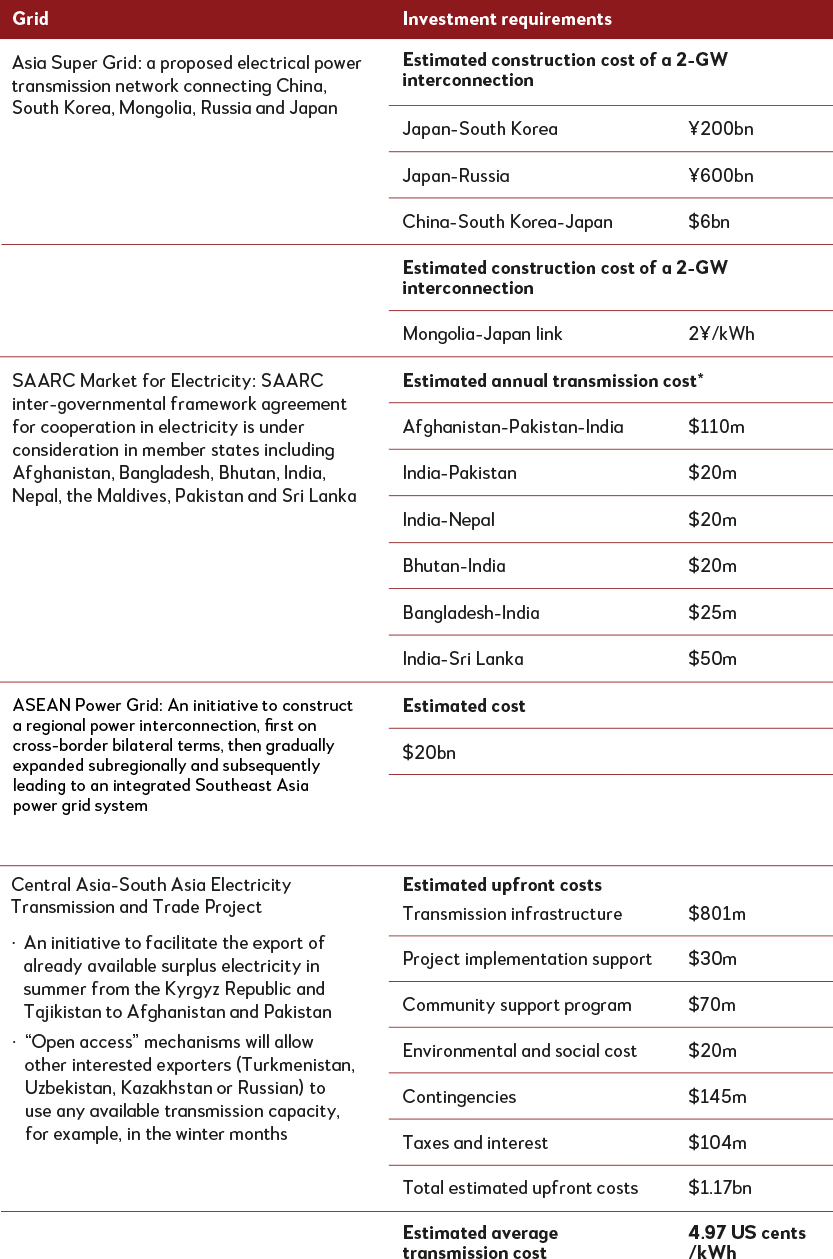When Softbank CEO Masayoshi Son announced he was planning to pursue his vision of creating a pan-Asian renewable energy grid, dubbed the Asia Super Grid (ASG), one could have accused him of over-optimism. The initiative, which would see the power networks of Japan, South Korea, China and Russia link up via Mongolia to tap that country’s vast solar and wind resources, is in stark contrast to the fragmented networks that exist within Asia today.
By encouraging countries to link up their grids, regions with untapped renewables capacity could attract much-needed investment, boost their own supplies and export their surplus. It will help Asia to wean itself off fossil fuels—a necessity in the face of rapidly rising electricity demand, growing resistance to coal and international pressures to meet the Paris Agreement and UN Sustainable Development Goals (SDGs).
While full integration across Asia is at best a long-term prospect, investments in regional connections have the potential to speed up decarbonization while cementing firmer ties across this vast and fragmented region.
Power plays
Home to 60 percent of the world’s population, responsible for over 40 percent of global energy use and almost 50 percent of related emissions, and the world’s largest driver of energy demand —Asia will increasingly be the main front in the battle to keep the rise in global temperature below 1.5°C. Yet to achieve this while ensuring access to “affordable, reliable, sustainable and modern energy for all” will be a formidable feat in a region where almost half a million remain without power, outages are still common and coal is abundant and inexpensive.
Much progress has been made. As the cost of solar and wind installations has fallen, renewables in the region are booming. India has invested so much that solar now costs around half that of coal power from the grid. Last year, China became the world leader in non-hydro renewables, attracting almost half of global investments. Overall, Asia trebled its renewable capacity in the past decade.
Yet rising demand means annual investments are still only half of what is needed to meet a target to double renewable energy’s share in the energy mix by 2030, which would keep the region on track to meet the Paris Agreement and SDGs., As a source of power, energy-dense coal could yet remain the favored fuel, despite growing health concerns and even as cleaner—but less reliable—renewables overtake coal in terms of megawatts installed. This is leading Asian nations to seek new ways to secure supply— including turning to their neighbors for green power.
Node to nowhere?
Compared with Europe’s long-established electricity market, where member states trade on average 11 percent of their electricity power structures within Asia are a disjointed affair. The vast distances and differences in terrain, infrastructure and demand mean that overall trade in electricity consumed is estimated at less than one percent, while some big users, like Japan and South Korea, are not connected to any neighboring grids.
Where links exist, they mainly involve bilateral agreements to export excess capacity, especially climate-dependent hydropower, on to neighbors. Bhutan, which has a 100-percent electrification rate, is the most active exporter, channeling about 70 percent of the electricity it produces via run-of-the-river hydropower onward to India (India, in turn, helped finance three major dams that generate most of the country’s power). Lao PDR, thanks to its favorable position on the Mekong River, has been exporting traditional hydropower to Thailand since the 1970s; it recently expanded its links such that around 60 percent of its electricity now flows beyond its borders.
Figure 7: Electricity trade, select Asian countries, 2016

*Source: BIMSTEC Energy Outlook 2030, South Asia Regional Initiative for Energy Integration, December 2017,
https://sari-energy.org/wp-content/uploads/2018/03/SARI-EI-Report-on-BIMSTEC-Energy-Outlook-2030-Rajiv-SARI-EI-IRADe.pdf
#Source: EIU calculations based on ibid and Statistics, International Energy Agency, https://www.iea.org/statistics, accessed Nov. 23, 2018.
Best of both watts
In economic terms, connections over larger geographies mean countries can take advantage of different time zones to sell power to their neighbors while their own people sleep, which makes sense for intermittent renewables like wind, which can blow day or night. “If you have a larger grid, you can transfer power as the sun moves,” says Eric Martinot, professor of management and economics at Beijing Institute of Technology.
Distance matters in Asia, where some of the richest resources are in far-flung, less populated areas. Mongolia, with just three million people, has a wind power potential twice the current global installed capacity. China suffers from supply bottlenecks in its own windy north, India is struggling to expand its grid infrastructure in line with a recent explosion in solar farms in the west and south, and across South Asia, 83 percent of hydro resources, much of which are in remote mountain areas, have yet to be exploited.
A plan to link up the grids of the eight countries that make up the South Asian Association for Regional Cooperation (SAARC) could add 36 GW of (mainly hydro) capacity—more than the current supply of all SAARC members outside of India combined—while reaping an estimated USD9 billion in annual net savings up to 2040. However, building all the necessary transmission infrastructure is just one of many hurdles to powering up the region. “Regional power plans are very challenging,” says Rajiv Panda, head-technical of the South Asia Regional Initiative for Energy Integration, established in 2000 with the goal of facilitating cross- border energy trade, improving regional energy security and clean energy development. So far, trade still only takes place on a bilateral basis (though Bangladesh may soon purchase hydropower from Nepal and Bhutan via India). Among the issues to iron out are licensing agreements, harmonizing technical standards and guidelines on transmission pricing.
With the price of storage falling quickly, countries will also need to weigh the costs and benefits of large- scale, complex transmissions projects against localized and distributed forms of energy that can be deployed more rapidly. Tetsunari Iida, chairperson of the Institute for Sustainable Energy Policies in Japan, would like to see more of that, as the share of renewables in Japan’s power mix is just 15 percent of the total, despite rapid expansion in recent years. Yet others argue that localized grids, while helpful in increasing energy access in various areas, fundamentally do not shift energy from energy-abundant places to areas of market demand. The following lists summarize a number of additional challenges and opportunities of regional power grids, drawn from examples in ASEAN.
-
Costs
- Cost of transmission infrastructure. A current ASEAN Power Grid (APG) plan is estimated to cost USD20 billion.
- Time and monetary costs of negotiations, such as licensing agreements, harmonising technical standards and guidelines on transmission pricing.
- Sacrificing localized and distributed forms of energy projects, in which energy is consumed closer to the point of generation.
-
Benefits
- Increasing clean electricity capacity. Natural gas accounts for about two-thirds of power generation in Thailand as domestic reserves of petroleum and coal are limited. In order to reduce gas dependency and maintain power security, Thailand’s electricity imports have tripled in the past decade.
- Saving billions in energy expenditure. Power integration in the Greater Mekong Subregion has resulted in USD14.3 billion in savings.
-
The Economist
- Reducing energy wastage. The primary goal of the Singapore-Malaysia interconnection since 1983 is power stability and peak demand support.
- Raising interdependencies among the region, and ultimately, stability. The Thailand-Lao PDR hydropower interconnection established in 1971 is one of the longest-standing power cooperation initiatives in the region.
- Boosting economic integration.
https://www.researchgate.net/profile/Aaron_Praktiknjo/publication/282860529_Development_Prospects_of_the_ASEAN_Power_Sector/links/561fc7d208aea35f267e0abe/Development-Prospects-of-the-ASEAN-Power-Sector.pdf
Both the SAARC and APG projects aim to adopt a market-based trading system in the vein of Scandinavia’s Nord Pool, which was established to balance intermittent hydropower from Norway with thermal supplies from its neighbors, helping lower prices for consumers.
It is now the largest international power trading market, pooling diverse sources, including wind power from Denmark and Sweden. In India, electricity is already traded openly across states and if a similar system can be extended to other economies, it could boost intraregional trading of renewable power. A variety of other regional grids are at various stages of development (see Table 8).
Table 8: Proposed Asian regional grids and investment requirements

*Includes maintenance costs.
-
How does one assess the benefits of such long-distance transmissions in light of the cost of investment? The example of energy pipelines might be helpful in answering this question—both wire grids and pipelines are fixed-route assets that facilitate cross-border energy trade. A comparison model built in the US shows total capital costs of electricity transmission, for the same energy content, are about twice that of pipelines, but the annual maintenance costs of the latter are roughly double that of wire grids. However, pipelines link countries to a finite source of energy (gas), while transmission lines open up other possibilities to renewable energy trade. Moreover, this cost-benefit comparison has not factored in carbon price (or carbon-cost savings)—a significant factor considering the need to meet the Paris Climate Agreement and SDGs.
-
Deeper ties
Such regional grid initiatives could potentially pave the way for economic ties in other areas, too, and create interdependencies that can add to regional cohesion. In Central Asia, when construction recently started on a project to connect Tajikistan and the Kyrgyz Republic—which have surplus hydropower—to Afghanistan and Pakistan, Afghanistan’s president hailed it as an opportunity to bring “peace and stability” to the region.
South Korea’s president, Moon Jae-in, is also a strong proponent of regional power integration and backer of the ASG, which he sees as a means both to exploit renewable resources (South Korea currently derives about two percent of its power from renewables, a figure barely changed for the last 20 years) as well as deepen regional ties. He has called on Russia to take part; South Korean and Chinese grid operators have already signed a cooperation agreement. North Korea has yet to formally join the ASG, but Mika Ohbayashi, director of the Japan-based Renewable Energy Institute, which is overseeing development of the ASG, believes a China-Russia-North Korea connection is likely and that the grid could even be a way to help stabilize the peninsula. “We have to find some way to help North Korea grow economically, renewable electricity is a must,” she says.
-
A wealth of flows
Asia has huge untapped potential for renewables, and regional networks could help develop more capacity, boost access and support stronger economic integration. But regional power grids will not happen overnight. Europe’s grid has been connected for over half a century and still only a tenth of power is traded among member states; Asia’s most developed interconnection projects, in South Asia and ASEAN, have each been in planning for around two decades and are only now taking their first steps toward multilateral trade.
As for the ASG, Ms. Ohbayashi reckons it will take some more years for Japan to connect to the rest of the Korean peninsula (the project has yet to receive formal government backing) but that it should happen, given the need to reach the goals set forth in the Paris Agreement. “I cannot imagine that Japan will not be connected by 2050,” she says. “If Japan tries to reduce 80 percent of its emission, 100 percent of renewable energy has to be realized and of course we need interconnections.” Whatever the eventual timeframe, what is clear is that further connections within Asia are likely, making regional power grids one more weapon in the climate change arsenal.
